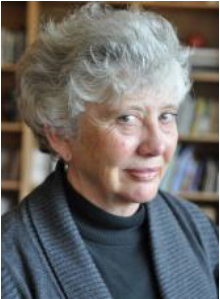Professor Errington “Goes to the Light Side”
Kua Vang, Anthropology Major
 I was shocked to hear that Professor Errington is retiring because she is so important to the Anthropology Department. Early on when I took Lisa Rofel’s Cultural Theory class she talked about Professor Errington’s work. When I took Susan Harding’s Evangelical Culture class she too talked about Professor Errington’s work. So, I always wanted to take a class with the person they talked about. I was happy when I saw that she was going to teach Culture and Politics of Southeast Asia during Fall 2014, despite the fact that the class was at eight in the morning. But I wanted to take the class for two reasons: to meet Professor Errington and to learn about a region in the world where my family comes from.
I was shocked to hear that Professor Errington is retiring because she is so important to the Anthropology Department. Early on when I took Lisa Rofel’s Cultural Theory class she talked about Professor Errington’s work. When I took Susan Harding’s Evangelical Culture class she too talked about Professor Errington’s work. So, I always wanted to take a class with the person they talked about. I was happy when I saw that she was going to teach Culture and Politics of Southeast Asia during Fall 2014, despite the fact that the class was at eight in the morning. But I wanted to take the class for two reasons: to meet Professor Errington and to learn about a region in the world where my family comes from.
My family migrated to the U.S. from Thailand and Laos in the 90’s. My parents, Yang Xiong and Ger Vang, are from an agricultural background and were not educated. When they immigrated they were placed in the city of Stockton, CA. They had a hard time finding a job and transitioning to Stockton. My mother eventually found a job at a poultry processing plant where she still works today. My father took longer to find employment but eventually found a job as an assembly line worker at a company that makes Styrofoam. He worked there for ten years until the company closed down. Over time we made Stockton our home, which was difficult but it provided my family with a new start and with new opportunities. I entered UCSC in 2012 and will graduate in Spring 2016 with a B.A. in Anthropology and a B.A. in Community Studies.
The thing that stood out the most about Professor Errington’s class was when she taught us about the Indonesian folk music and dance called Gamelan. At first, it was funny because it sounded like a bunch of random instruments just playing together. Then we learned about how the rhythm plays a big role in the songs and the way it is played is very specific. There is a specific pattern that is important to the way the stories are told. And another interesting aspect of Gamelan is that the dancers guide musicians by indicating when certain verses are coming or when major changes are to be made. Thus, in Gamelan the dancers are like the conductors to the “orchestra.”
When we studied Gamelan I immediately thought of my Hmong traditional folk songs called Lug Txaj. It was so funny because I grew up listening to this music because my parents and all other adults and elders listen to it all the time. There are even specific radio shows out of Fresno that my parents listened to regularly every day. They don’t sing along to the songs. Instead, they pay attention to thestructure. Every song begins with a specific vocal pattern and then follows an established grammar of beginning, middle, end and transitions in between. The songs are not like our pop songs; they are more like operas or even television soap operas. My parents would get excited about the dialogues that are presented through the songs as if they were watching a TV show or reading a good novel. In fact, the language that the singer uses is very complicated so it is very hard for me to understand the songs. It is like poetry. It is a professional Hmong and I only speak conversational Hmong. But my parents would understand it and would converse to each other about the plots and events narrated through the songs.
I never really thought about these folk songs at all before my class with Professor Errington. They were never anything I enjoyed. I don’t understand them. I don’t get what they were saying. I preferred contemporary Hmong and American pop music. I never even thought about the significance of these songs until Professor Errington’s class. She taught us how to reflect ever so subtly and deliberately on the smallest details of everyday culture. She took us by the hand to look at a strange music and dance form like Gamelan, and helped us reflect on the depth of the tradition and role Gamelan plays in personal relationships and transmitting common values amongst the community. Now, I am able to transfer some of this patience and attention to Lug Txaj.
Shelly is very relaxed and chill. I want to thank Shelly for her class and the way she helped me reflect on the very small things in my culture that I took for granted. It would have been nice to take more classes with her to gain more insight and perspective about how she studies the world.
